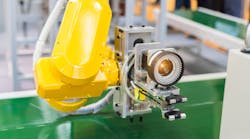While increasing supply chain visibility is an on-going process, another tool — machine vision—can help companies reach a deeper level of visibility.
New technology capability continues to increase for both the acquisition of data and the means to analyze that data. It was finding practical applications for that data that led Dr. Amy Wang to co-found Cogniac.
Based in San Jose, Calif., the start-up company, which was recently selected to join the SAP.iO accelerator program, uses several visual sources to track machinery, equipment, etc. However, it’s the funneling of the data produced by vision cameras, security cameras, drones and smartphones, onto an artificial intelligence platform that allows companies to actually “see” the issues that they are concerned about.
Using artificial intelligence (AI) research, human-computer interaction tools, and large-scale data management, Cogniac makes computer vision easier to deploy.
The company provides an enterprise platform that facilitates automating any visual task. For example, if a company is seeking to ensure quality by tracking potential damage of a product through the supply chain, Cogniac can use the visual data to identify the problems through a feedback system that works through third-party apps to provide alerts and notifications to customers.
“We are taking out the human error in the supply chain,” explains Wang who serves as the vice president of systems. “Using deep learning, our software can achieve a much higher degree of reliability than people are able to do.”
In addition to the basic steps of visualization, Cogniac can provide a customized AI model based on feedback. And these systems are “intelligent” in that they can learn what the company calls characterization based on the input from users as well as archives images. Cogniac supports multiple deployment options: cloud, gateway, on-premises and a hybrid approach.
This new learning is based on convolution neural networks, which are layers of neurons capable of performing tasks such as object recognition. The neurons are based on human neurons and are known as deep learning. These models can process higher image variation and provide application performance levels above 90% prior to human corrections, the company says.
To ensure that all of this technology is, in fact, easy to use, Wang says that the system was designed for use by non-technical user. A company doesn’t have to have a data scientist on staff as the learning engine is capable of finding optimal architecture and configuration variations to create models aligned with the user’s applications.
To explain more clearly how this works, Wang provides the example of how a manufacturing company used the technology in its kitting and warehouse management to ensure an optimized supply chain.
In a complicated warehouse with over 100K parts, workers manually pick the orders. So Cogniac did an audit of the process and found that there was a very high error rate. “Part of the reason was that many parts look similar,” says Wang. Using cameras Cogniac software was able to recognize each individual part, which increased the accuracy of the kits.
This sample application can be used to ensure that the proper items are shipping and ascertain what, if any, damages incurred during shipping.
“We continue to find uses for this application across the supply chain,” “says Wang. “Once you start standarizing the process across the entire supply chain, it can become a very powerful tool.”
Wang feels the application of this type of technology as having huge growth potential as she says we are just in the early stages of deep learning, which is the artificial learning function that mimics the workings of the human brain in detecting objects and making decisions. “We are now at the basic capability of this technology, but I see a steep increase in the adoption of this type of technology due to its range of benefits.”
And for now, the supply chain is the early adopter of these benefits.




